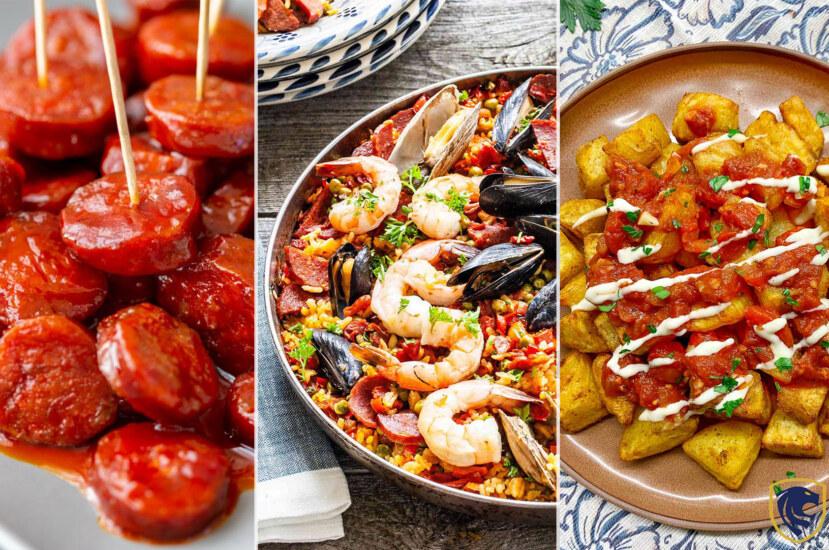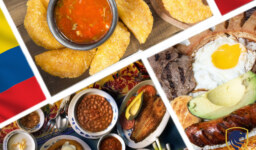Europe is home to some of the most fascinating cuisines. Spain has some unique traditional foods which have evolved over the years. They are rich in flavors. Most of them are not very spicy. But there are a few exceptions to this.
Seafood Paella
Paella is the most prominent dish when it comes to Spanish cuisine. Paella has a lengthy history. If you’re a traveler who is familiar with Spanish food, you’ve probably heard of paella before. But like with many popular foods, there’s nothing like the real deal prepared in the place where the dish was created.
However, as the popularity of paella has increased, so have the many interpretations of Spanish cuisine. Paella options are available now such as vegan Paella and Paella de Marisco. The latter is the most well-known variation of the dish on the globe. This style of seafood paella has increased in popularity as a result of the fresh catch from the Mediterranean. Muscles, shrimp, fish, and even a few sliced-up chorizos can be found with the rice.

Seafood Paella
Paella is generally made in a big, shallow pan over an open fire for those following along at home. However, an ordinary stove will suffice. To achieve the dish’s famed golden hue, use an olive oil base.
Tapas
Tapas is a Spanish dish that has been spread across the globe introducing Spanish tastes to foreigners. If you want to witness the surprising taste of tapas visiting a tapas bar, is highly recommended. However, it is through the experience of tapas that this dish truly fires Spanish culture.

Tapas
Tapas may now introduce you to a world of tantalizing flavors and delectable textures. Most tapas establishments’ menus will give you a choice of selections. You get to choose what and how many dishes you want. The smokey crunch of Spanish chorizo. The texture of the Iberian ham is silky. Squid bites in a crispy batter. Each of these little delicacies is lovely in its own right.
Patatas bravas
Patatas bravas – “brave potatoes” – is a tapas classic Spanish dish known for its spicy sauce. However, it is uncommon in a country that normally avoids fiery cuisine. The potatoes are diced and shallow fried, and they are served the same way everywhere. The sauce can range from spicy ketchup to garlic mayonnaise with a sprinkle of pimiento (smoked paprika) or both.
According to Spanish cooks, the dirtier the bar, the better the bravas. I know, pretty confusing, right?

Patatas bravas
“Tapas evolved in southern Spain and is an adaption to the social culture of eating and drinking outside the home. Also, it serves as the same social role as the English public house and other comparable institutions,” adds Shawn Hennessey, who leads Seville tapas tours. Tapas is mainly served in family gatherings and in elegant friends communal atmosphere.
Jamon Iberico – Iberian Ham
Did you know that Spanish is the world’s largest ham producer? According to statistics they produce 40 million hams every year. That makes ham to be abundant food in Spain so does Jamon Iberico. Spanish people love to eat salted and air-dried ham which makes the country the world’s largest ham consumer too.

Jamon Iberico – Iberian Ham
This dish developed in Spain as a result of a Muslim conquest of the country in the 15th century. You can find two varieties of this delicious dish in Spain. They are, Jamon Serrano and Jamon Iberico
In Spain, there are two primary varieties of cured ham: Jamon Serrano and Jamon Iberico. Jamon Iberico is more costly and of higher quality than the other variant. According to Spanish foodaholics, Jamon Iberico is more expensive and of greater quality than the other type.
Chorizo
Chorizo, one of the most prevalent components in the greatest Spanish cuisine, is available all over the world. However, the sausage’s origins may be traced back to 16th-century Spain. Over the next five centuries, it evolved into a range of tastes, and nowadays, you can get spicy, sweet, smoked, dry-cured, and even vegan chorizo.

Chorizo
To return to its origins, traditional Spanish chorizo is a fermented, cured, and smoked pig sausage. It’s then diced and seasoned with Spanish paprika, salt, garlic, and olive oil to taste.
Chorizos in Spain are divided into two categories: Picante (spicy) and Dulce (sweet) (sweet). This is the sort of pimento (Spanish paprika) used in the well-known Spanish meal. The pimenton gives chorizo its distinctive rich rouge color, regardless of the variety.
The exquisite curing procedure contributes significantly to the delectable flavor of Spanish chorizo. However, whether smoked or not, it may be found in a variety of dishes, such on a Bocadillo and in Paella. You may eat it cold as a tapas or grill it and serve it with some real tomato sauce and red wine on the side.
Pimientos de Padrón
Pimientos de Padron, a real Spanish delicacy and one of Spain’s most intriguing dishes, is another popular tapa. Padrón peppers are named after the Spanish town of Padrón. Padrón is located in Galicia, in northwest Spain, just above Portugal. These peppers are processed by a few traits. The first characteristic is their form. Padrón peppers are tiny, measuring roughly two inches in length. Their bodies, however, contort and bulge or narrow in particular areas.

Pimientos de Padrón
Their flavor is their second distinguishing feature. They are typically mild peppers. However, up to a quarter of the peppers have a strong, fiery flavor. The pepper’s savory level is determined by how it is cultivated. Also, many variables influence its flavor, including whether it is derived solely from the soil. The pepper’s spiciness is determined by how it is cultivated. Many variables influence its flavor, including whether the soil or the entire plant receives water.
This has resulted in an intriguing predicament in which you have no idea how hot each Padrón pepper is until you eat it. Pimientos de Padrón is customarily cooked in hot olive oil until crumpled, with the stalk still attached. Finally, these peppers with wrinkles should be seasoned with salt.
Fabada

Fabada
When you think of Spanish food, you might not think of winter warmers. However, the Iberian peninsula may become rather chilly, and when it happens, the natives enjoy a hearty fabada. This famous bean stew is ideal for when the weather cools down and delivers a flavorful punch. You may use chorizo, morcilla (blood pudding), and other spicy meats in your stew. Fabada is originally from the area of Asturias. However, there are several regional varieties available in Spain.




